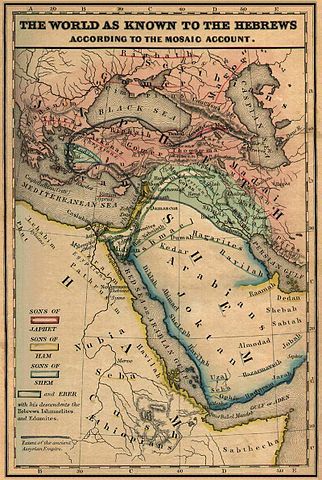
Ashkenaz is shown in Phrygia in this 1854 map of “The World as known to the Hebrews” (Lyman Coleman, Historical Textbook and Atlas of Biblical Geography) | (c) en.wikipedia.org/wiki/Ashkenaz
Today, we delve into the fascinating historical discussion surrounding the right of Jews to bear arms in early Ashkenaz. In this article, we explore the complex relationship between Jewish communities and secular authorities, focusing on their legal status and the evolving permission to bear arms. It is important to note that our analysis is centered on the medieval period, steering clear of contemporary debates on this controversial topic.
Embark on a remarkable journey to enrich your understanding of our shared history with a luxurious riverboat cruise by Kosher River Cruises. Indulge in the elegance of kosher vacations, as you enjoy fine dining and daily services amidst breathtaking scenery. Experience the pinnacle of comfort and opulence onboard our luxury vessel, as we transport you to fabulous destinations. Elevate your Jewish vacation to extraordinary heights with Jewish tours, kosher resorts, and an unforgettable experience beyond the ordinary.
Jews as “Serve Camara Regis”: Valued Assets under Royal Protection
In early European centers, Jews maintained a unique relationship with the king. They were recognized as “serve camara regis,” meaning servants of the royal chamber. This designation was bestowed upon them to safeguard their interests, protecting them from harm inflicted by nobles, peasants, or the Church. The king regarded the Jewish community as a valuable source of income and economic prowess. The question arises: If Jews were essential to the king’s economic stability, should they be allowed to bear arms? Or did opposition from the Church influence their right to arm themselves?
Armor and Nobility: Assessing Jewish Access to Arms
Armor served as a symbol of nobility and was predominantly associated with the upper classes. Peasants were generally denied the privilege of bearing arms, often resorting to improvised weapons when called upon to defend the king’s interests. Within this context, the status of Jews becomes intriguing. Jewish access to arms during the medieval period is a subject discussed by legal historian Guido Kisch, whose work sheds light on the organic development and subsequent sealing of charters specifying Jewish privileges.
Charters and Privileges: Jewish Rights and Responsibilities
Medieval Jewish rights were frequently documented in charters issued by the king. These legal documents outlined the privileges granted to Jewish communities. However, examining the right to bear arms requires careful analysis. In historical depictions, such as the return of a Torah scroll to Jews, we observe their distinctive garb, including the yudenhood required by the Fourth Lateran Council in 1215. While the illustrations may not accurately represent the handling of the Torah scroll, they offer valuable insights into the societal expectations imposed upon Jews.
The Sachsenspiegel: A Glimpse into Medieval German Legal Practice
One of the essential legal codes from the 13th century, the Sachsenspiegel, provides valuable insight into medieval German society and its legal practices. Illustrated to facilitate comprehension by illiterate individuals, it contains a notable image depicting the king, clergy, women, and a Jewish figure. Notably, the clergy and women were considered defenseless, with the expectation that the king would protect them. However, evidence suggests that Jews were also involved in public defense, participating in the protection of their communities.
Erosion of Jewish Rights: The High Middle Ages and Beyond
While evidence suggests that Jews were permitted to bear arms during the early medieval period, a decline in this privilege can be observed in subsequent centuries. The erosion of Jewish rights coincided with various historical factors, including Pope Innocent III’s papacy in the 13th century. As the status of Jews degraded, they were increasingly restricted from carrying weapons, even during perilous endeavors such as business travels.
Examining the historical trajectory of Jewish self-defense and legal status in early Ashkenaz allows us to better understand the complexities of this issue. It is crucial to approach this subject with historical context and acknowledge the significant differences between the medieval period and contemporary society. While this exploration provides valuable insights into the past, it should not be used as a justification for particular attitudes in modern times.
